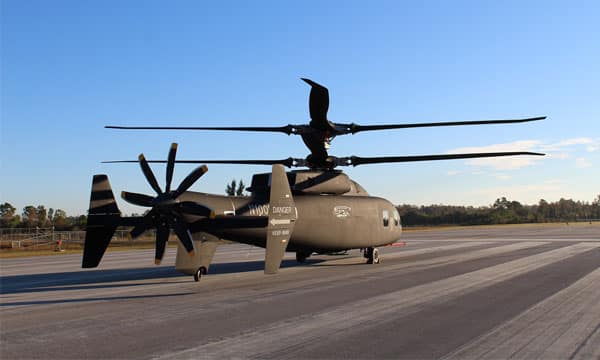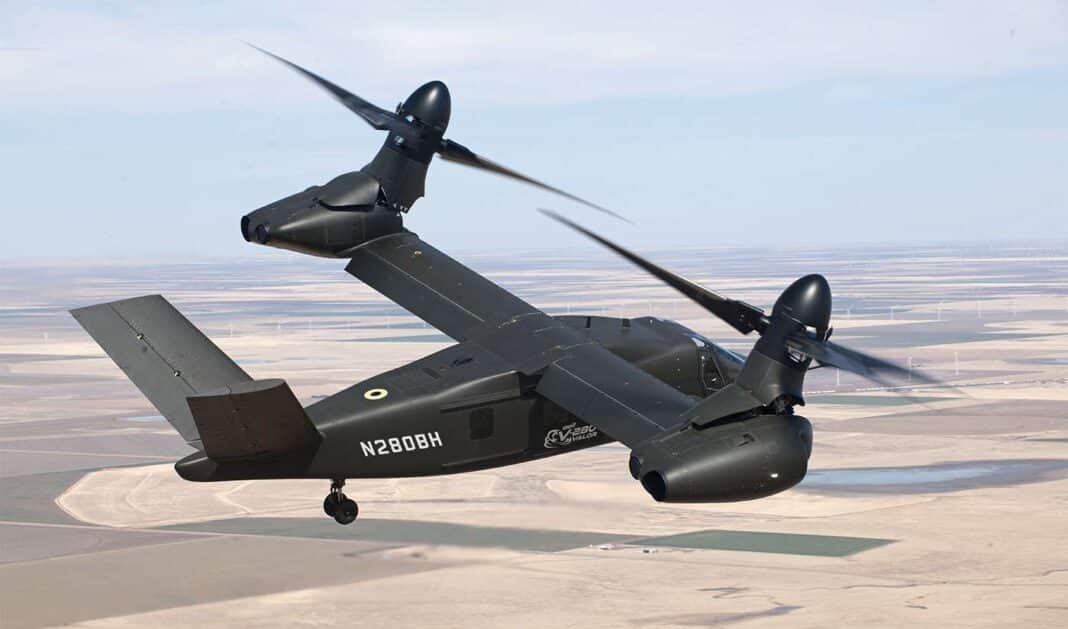Launched in 2009, the Futur Vertical Lift program, or FVL, one of the 6 pillars of the “Big 6” super-program, aims to replace all the rotary wings in service in the US Army with new generation aircraft. , with performances far ahead of those of the helicopters currently in service. In 2016, it was decided that the first program to emerge would be the Future Long Range Assault Aircraft, or FLRAA, to replace the UH-60 Black Hawk maneuver helicopters. To do this, the new program would be based on the Joint Multi-Role technology Demonstrator or JMR-TD, a technology demonstrator program launched in 2013 between Bell and the Sikorsky-Boeing alliance.
Bell's demonstrator, the V-280 Valor, made its first in December 2017. It is an aircraft using tilt rotor technology already employed on the V-22 Osprey in service with the US Marines Corps, designed by Bell and Boeing. Sikorsky's SB-1 Defiant, for its part, uses a counter-rotating rotor, like the devices designed by the Russian Kamov, and a propeller, on the basis of its S-97 Raider demonstrator. But technological difficulties delayed the program, which only made its first flight in March 2019.

And that's where the problem lies, according to the US Army. Indeed, there is no question, according to statements by Secretary to the Army Ryan McCarthy, modify the schedule of the FLRAA program to give Sikorsky-Boeing time to catch up with their competitor, who has already logged more than 160 hours of flight time, and Satisfies all U.S. Army test programs. “Time is a luxury that we do not have,” he declared, while specifying that this did not mean that the attribution of the program had been recorded. However, this announcement sounds like the prelude to a disastrous sentence for Sikorsky when the objective of the selection program is above all to be based on proven performance and reliability, and not on technological projections. As the Defiant made its first flights, the Valor continued to show its capabilities, whether by validating military procedures like the rope transfer, or by showing his ability to fly independently, without a pilot, further widening the gap with his opponent.
Still, for now, the V-280 Valor and the DB-1 Defiant are only demonstrators, and they will have to be modified to make prototypes that meet the requirements of the US Army. But insofar as the FLRAA program was designed on technological bases resulting from the JMR-TD demonstrator program, these modifications will not be of such a nature as to profoundly disrupt the architecture or the performance of each device. It is therefore unlikely that Sikorsky will be able to catch up on the Valor, which increasingly appears to be the favorite of this competition, which will be refereed in the summer of 2021.

But even if Sikorsky were to lose the FLRAA program, it probably wouldn't be the end of the Defiant and its unique architecture. Indeed, on this same technical basis, the manufacturer offers the Raider X model for the Future Attack Reconnaissance Aircraft program, a light reconnaissance and attack aircraft intended to replace the OH-58 Kiowa helicopters withdrawn from service in 2014, but also to strengthen the firepower of the AH-64 Apache and their successors. However, in this competition, its longtime opponent, Bell, does not offer a new generation device, but the Bell 360 Invictus, a classic design helicopter with optimized performance. In fact, tilt rotor technology is hardly compatible with the design of a light helicopter weighing less than 6 tonnes. As for the other preselection candidates, neither Karem and his AR40, nor the concept presented by AVX / L3 have a real chance of being selected among the 2 finalists.
Today, only Boeing, whose model has still not been unveiled, could come and play the spoilsport between Sikorsky and Bell in this competition. But the Seattle firm has shown, in recent years, to be capable of quite spectacular turnarounds, winning in quick succession. the MQ-25 Stingray on-board drone program of the US Navy, and the US Air Force TX program, to replace the T-38 Talon advanced trainer aircraft in service since the 80s. But while Sikorsky has invested tens of millions of dollars in R&D since the turn of the century around its propeller and rotor technology counter-rotating around the X2 then S-97 programs, and that Bell did the same concerning the tilting rotors around the V-22 program, Boeing, which nevertheless produced the AH64 Apache and the CH-47 Chinook, two emblematic aircraft of the US Army, did he not seem to have invested in this type of new rotary wing architecture. It is therefore not known on what technological basis the manufacturer's proposal will be built.

Among the new technological architectures for helicopters likely to meet the demands of the battlefield of tomorrow, particularly in terms of speed and extended range, the one proposed by Airbus Helicopters with the X3 for the Racer, is most promising, even if it had not been selected by the US Army for rather obscure reasons. The configuration imagined by the European helicopter maker is based on two nacelles equipped with a propeller positioned on each side of the airframe, and playing both the role of propulsion and counter-rotating rotor, all driven by a direct power take-off on the turbine of the device. This solution, as elegant as it is ingenious, makes it possible to reach speeds of nearly 400 km / h without having to weigh down or unduly complicate the helicopter and its maintenance. Designed as part of a purely civilian European funding program, the Racer has not yet been converted into a military program. But it would be very surprising if this did not happen in the years to come.
[armelse] [armelse]
75% of this article remains to read,
Subscribe to access it!
The Classic subscriptions provide access to
articles in their full version, and without advertising,
from 6,90 €.
Newsletter subscription
Register for the Meta-Defense Newsletter to receive the
latest fashion articles daily or weekly

